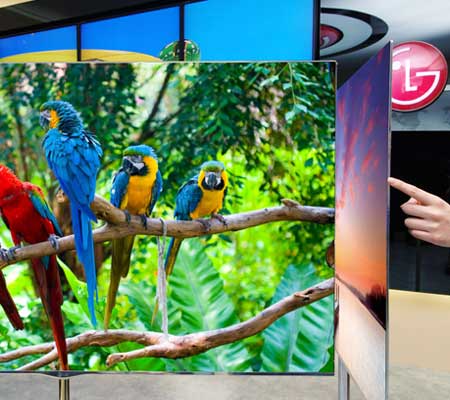Are OLED TVs the Next Big Thing in the TV Space?
August 17, 2012

There has been quite a buzz since CES last January about a new TV technology called OLED. OLED stands for Organic Light Emitting Diodes and they claim to be brighter, more efficient, thinner and feature better refresh rates than LCD or Plasma. So what makes an OLED TV so much better than the TV's already on the market today?
- The response time is much faster. According to LG their OLED TV is 1,000 times faster than current LCD models.
- Thickness...or should I say thinness. These TVs are ridiculously thin. Some prototypes have been as thin as 0.3 mm thick!
- Better viewing angles. Some claim up to 180 degrees, which means it doesn't matter where you place it, there won't be a bad seat in any room.
- OLEDs draw less power and contain no bad metals for those concerned with their environmental footprint.
- And this last one has the most "cool" potential, OLED panels can be made flexible and transparent (remember our Minority Report blog post from earlier?). The future is on its way!
From the introduction of the LED TV in 2009 it has been promoted as a new and innovative technology. If you already have an LED TV, why would you want a new OLED TV? Isn't it the same thing with an "O" in front of it? Not exactly, actually not even close. Here's a little secret that the marketing departments at LG, Samsung, Panasonic, Sharp, Toshiba, Sony, etc. don't want you to know. LED TVs are the EXACT same as an LCD TV as far as display technology, refresh rates, thickness, etc. LCDs do not create light, they require a light source. Old-school LCD TVs use fluorescent lamps (called CCFLs) and the ones currently marketed as LEDs are just using Light Emitting Diodes (LED) in the place of CCFLs. LEDs are certainly better and brighter than a standard LCD but it's a stretch to consider it a dramatic step forward in TV technology.
OLED is that dramatic step forward that could change the way everyone enjoys TV. OLED panels don't need lamps at all as they are self-illuminating devices. This is what allows the TV to be so thin and also what gives the display the potential of being transparent and flexible. So back to our original question, are OLED TVs the next big thing in the TV world? Right now the price tag of an OLED TV is over $8,000 so don't expect this technology to take a dramatic leap forward during the holiday rush this year. It may be another year or two before OLEDs truly become affordable to the masses but when that does happen, I would expect all the other current TV technologies will become obsolete.
